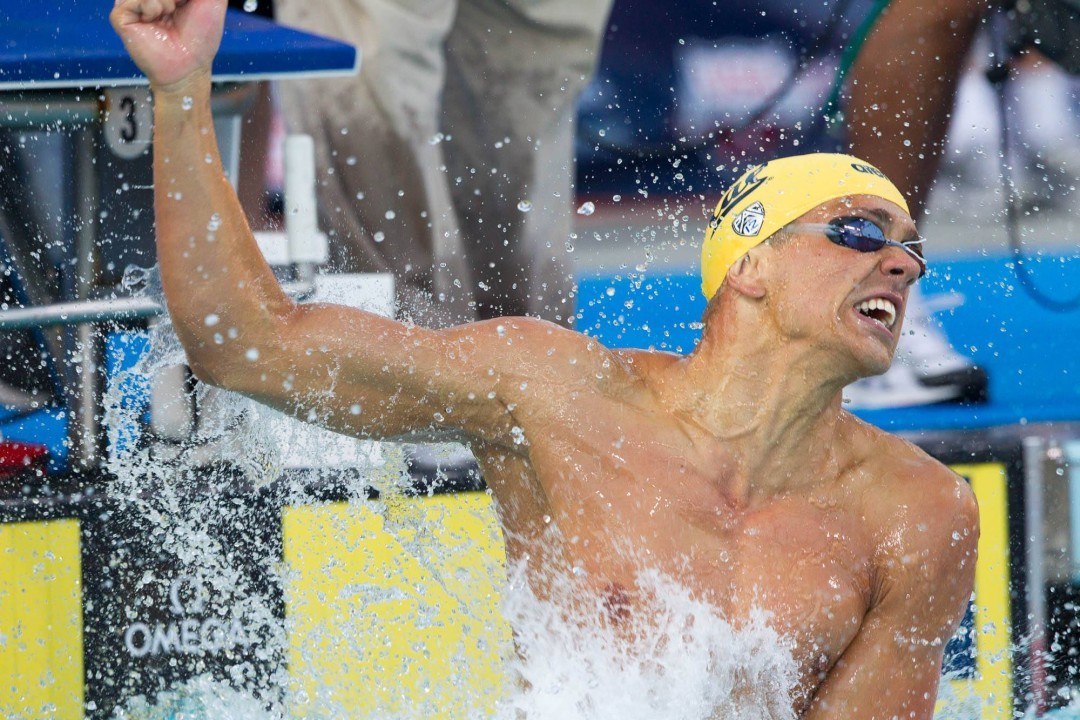BridgeAthletic builds and delivers customized stroke/distance-specific dryland programs optimized for each of the athletes they work with. With individual swimmers including Anthony Ervin, Tom Shields, Natalie Coughlin and Nathan Adrian and teams such as Palo Alto Stanford Aquatics training with Bridge, the company is already making an impact with some of the top performing athletes in the sport. This is part two of a three part series that will explain some the Bridge athletes’ favorite exercises.
Today we will feature Tom Shields. Tom is currently one of the best butterfliers in the world. Tom had a breakout meet last summer at US Nationals, beating a stacked field to win both the 100m and 200m butterfly events. His main strengths are his underwaters and his improved endurance. The three featured Bridge exercises are the Band Barbell Front Squat, the Dowel Thoracic Mobility, and the Komodo Dragon Walk.
Band Barbell Front Squats
Equipment: For this exercise you will need a weight rack equipped with a barbell, and two resistance bands that are attached to the weight rack or to the ground.
Starting Position: Standing upright with your feet at shoulder width, rest the bar on your shoulders. Extend your elbows forward and place your fingertips under the bar.
Movement
– To begin, bend at the hip and knee allowing your body to squat down. Control your descent until your thighs are parallel to the ground.
– At the bottom push upward, keeping your center of gravity over your feet to avoid falling forward, until your return to the start position. Pause at the top of the movement to avoid bouncing.
– Repeat this movement until you have achieved your desired number of reps.
– As you become more comfortable with the movement, increase difficulty by either giving the bands an extra wrap around the bar or by adding weight to the bar.
Note: This is a higher-level exercise. Be sure to work through your squat progression to master the front and back squat before adding resistance bands. The squat is a motion that we use to build lower body and core strength. The front squat is particularly good for swimmers because it emphasizes the quads, which help drive the kick and underwater work. The band is a great addition to the front squat for swimmers, because it emphasizes hip drive throughout the movement. Tom is one of the best underwater swimmers in the world, and we use the band front squat to continually improve this strength of his.
Dowel Thoracic Mobility
Equipment: You will need one long dowel. Make sure the dowel is light and can be easily gripped.
Starting Position: Begin lying flat on your stomach with your neck relaxed, your forehead resting against the ground and your arms extended forward. Rest your hands on the dowel.
Movement
– Keeping your chest against the ground, lift the dowel off the ground. Keep going until your level of flexibility restricts you.
– Pause. Return to your starting position allowing your hands to touch the ground before repeating.
Shoulder flexibility is imperative for all swimmers, and butterfliers in particular. Tom has been working hard on improving his thoracic mobility for the last five years and it is really paying off. The Dowel Thoracic mobility exercise is something that you can do at home with a simple broomstick. It works on both range of motion and flexibility. The more mobile your thoracic spine is, the better your catch will be and the more water you can hold. If your thoracic spine is locked up your catch will not be as efficient, especially at the end of a race. This was evident at the end of both the 100m and 200m fly races a couple weeks ago at Nationals when Tom was able to push through for strong finishes in both.
Komodo Dragon Walks
Equipment: You will not need any equipment for this exercise.
Starting Position: Start in push up position with your arms in full extension, and a slight bend in your elbows.
Movement:
– Simultaneously lift your back left foot and right arm. Move your left leg forward, placing your foot roughly halfway between your right foot and your arms, while simultaneously moving your right arm forward at a comfortable distance.
– As you plant your foot and hand, perform a pushup.
– You will repeat this movement causing you to move forward each time you bring your foot and hand forward.
One of the keys in athletic motion is the transfer of energy from your core to your extremities. The Dragon Walks are really good for what we call ‘finger tips to toes’ connection as the exercise forces coordination between the lats, obliques, hip flexor and legs. This is one of our more advanced body weight exercises at BridgeAthletic. All of the athletes in our system start with mastering kneeling and regular pushups, then spider man pushups, progressing to the Komodo Dragon Walk.
JOIN TOM SHIELDS AND SIGN UP AT BRIDGEATHLETIC HERE!
ABOUT BRIDGEATHLETIC
 BridgeAthletic works with elite professional, collegiate, and club swimming programs to provide a turnkey solution for dryland training. Led by Nick Folker, the top swimming strength and conditioning coach in the world, our team builds stroke-specific, custom-optimized dryland programs for each of our clients. The individualized workouts are delivered directly to athletes via our state of the art technology platform and mobile applications. Check Nick and BridgeAthletic out as recently featured in SwimSwam.
BridgeAthletic works with elite professional, collegiate, and club swimming programs to provide a turnkey solution for dryland training. Led by Nick Folker, the top swimming strength and conditioning coach in the world, our team builds stroke-specific, custom-optimized dryland programs for each of our clients. The individualized workouts are delivered directly to athletes via our state of the art technology platform and mobile applications. Check Nick and BridgeAthletic out as recently featured in SwimSwam.
ABOUT NICK FOLKER
 Nick Folker is the Co-Founder and Director of Elite Performance at BridgeAthletic. Nick’s roster of athletes includes 35 Olympians winning 22 Olympic Medals, 7 team NCAA Championships and over 170 individual and relay NCAA championships. Megan Fischer-Colbrie works as the Sports Science Editor at BridgeAthletic. Megan was a four-year varsity swimmer at Stanford, where she recently graduated with a degree in Human Biology. The Championship Series by BridgeAthletic is designed to empower athletes with tips from the pros that will help them reach peak performance come race day. We will be covering competition-focused topics such as nutrition, recovery, stretching, and mental preparation.
Nick Folker is the Co-Founder and Director of Elite Performance at BridgeAthletic. Nick’s roster of athletes includes 35 Olympians winning 22 Olympic Medals, 7 team NCAA Championships and over 170 individual and relay NCAA championships. Megan Fischer-Colbrie works as the Sports Science Editor at BridgeAthletic. Megan was a four-year varsity swimmer at Stanford, where she recently graduated with a degree in Human Biology. The Championship Series by BridgeAthletic is designed to empower athletes with tips from the pros that will help them reach peak performance come race day. We will be covering competition-focused topics such as nutrition, recovery, stretching, and mental preparation.

Wow, that komodo dragon walk looks hard, but good!
They’re really fun. My unit in the military taught it to us in basic. Doing only a few reps tires you out, so imagine crawling around your bunk carpark during your free time!!!